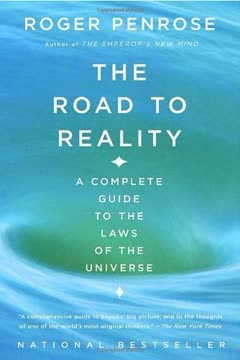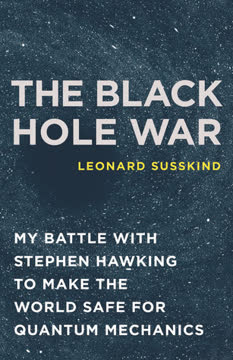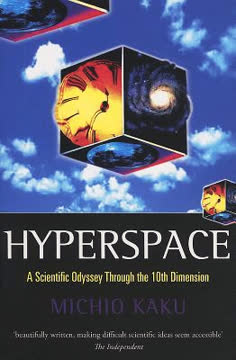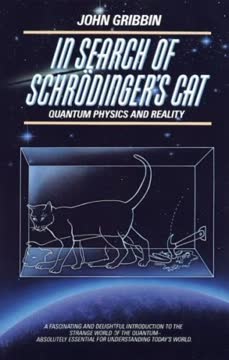Key Takeaways
1. Space and time are not absolute, but relative and intertwined
"From henceforth, space by itself, and time by itself, have vanished into the merest shadows and only a kind of blend of the two exists in its own right."
Relativity revolutionizes our understanding. Einstein's special theory of relativity overturns our intuitive notions of space and time as fixed, unchanging entities. Instead, it reveals that they are deeply interconnected and can vary depending on an observer's motion. This radical shift in perspective forms the foundation for understanding the nature of the universe at its most fundamental level.
Spacetime emerges as a unified concept. Rather than treating space and time as separate dimensions, relativity combines them into a single four-dimensional continuum called spacetime. This unification allows for a more accurate description of how events unfold in the universe and explains phenomena that cannot be accounted for by classical physics. The geometry of spacetime, described by the Minkowski metric, becomes crucial for understanding the behavior of objects moving at high speeds or in strong gravitational fields.
2. The speed of light is constant and forms a universal speed limit
"According to common sense, if we run fast enough we could in principle catch up with the front of the beam of light as it advances forward. Common sense might even suggest that we could jog alongside the front of the beam if we managed to run at the speed of light. But if we are to follow Maxwell's equations to the letter, then no matter how fast we run, the beam still recedes away from us at a speed of 299,792,458 meters per second."
Light's speed defies intuition. The constancy of the speed of light in all reference frames is a cornerstone of special relativity. This seemingly simple fact has profound implications for our understanding of the universe. It challenges our common-sense notions of motion and leads to counterintuitive effects such as time dilation and length contraction.
A cosmic speed limit emerges. The speed of light serves as a universal speed limit, imposing constraints on the behavior of matter and energy throughout the cosmos. This limit is not merely a practical barrier but a fundamental aspect of the universe's structure. It plays a crucial role in:
- The formulation of Einstein's famous equation, E=mc²
- The behavior of particles in high-energy physics experiments
- The ultimate fate of massive stars as they collapse into black holes
3. E=mc² reveals the profound relationship between energy and mass
"The energy locked up in mass carries with it a factor of the speed of light squared. Since the speed of light is so great compared to everyday, run-of-the-mill speeds (the υ inmυ2 ) it ought to come as no surprise that the energy locked away inside even quite small masses is mind-bogglingly large."
Mass and energy are interchangeable. Einstein's famous equation, E=mc², demonstrates that mass and energy are essentially different forms of the same thing. This equivalence has far-reaching consequences, from explaining the source of the sun's power to enabling the development of nuclear energy and weapons.
Vast energy potential exists in matter. The enormous factor of c² in the equation means that even tiny amounts of mass contain immense amounts of energy:
- 1 kg of matter contains 9 x 10^16 joules of energy
- This is equivalent to the energy released by exploding about 21.5 megatons of TNT
- The sun converts only about 4 million tons of mass into energy every second, yet this powers all life on Earth
4. Special relativity leads to time dilation and length contraction
"Einstein's universe is one in which moving clocks tick slowly, moving objects shrink, and we can journey billions of years into the future."
Time slows for fast-moving objects. Time dilation is a consequence of the constancy of the speed of light and the relative nature of simultaneity. As objects approach the speed of light, time passes more slowly for them relative to stationary observers. This effect has been confirmed experimentally:
- Muons produced in the upper atmosphere reach the Earth's surface due to time dilation
- Atomic clocks on GPS satellites must be adjusted to account for relativistic effects
Objects contract in the direction of motion. Length contraction is the complementary effect to time dilation. Objects moving at high speeds appear shortened in the direction of their motion when observed from a stationary frame of reference. While usually imperceptible in everyday life, this effect becomes significant for objects moving at relativistic speeds:
- A 1-meter rod moving at 87% the speed of light would appear to be only 50 cm long to a stationary observer
- This effect helps explain why nothing can exceed the speed of light, as objects would need infinite energy to be compressed to zero length
5. Spacetime is a four-dimensional fabric with its own geometry
"Spacetime really does seem to work—the notion of a unified space and time makes sense, just as Minkowski said."
A new geometric framework emerges. Spacetime provides a unified mathematical description of the universe that incorporates both spatial and temporal dimensions. This four-dimensional continuum has its own unique geometry, described by the Minkowski metric, which replaces the familiar Euclidean geometry of flat space.
Invariant intervals define spacetime structure. The fundamental quantity in spacetime is the invariant interval, which remains constant for all observers regardless of their relative motion. This interval is given by:
- s² = (ct)² - x² in one spatial dimension
- s² = (ct)² - (x² + y² + z²) in three spatial dimensions
Where: - s is the spacetime interval
- c is the speed of light
- t is the time coordinate
- x, y, and z are spatial coordinates
The invariant interval provides a way to describe events and their relationships in a manner that is consistent for all observers, forming the basis for understanding causality and the structure of the universe.
6. The Standard Model describes fundamental particles and forces
"The Standard Model takes as its starting point the existence of matter. More precisely, it assumes the existence of six types of 'quark,' three types of 'charged lepton,' of which the electron is one, and three types of 'neutrino.'"
A unified theory of particles and forces emerges. The Standard Model of particle physics provides a comprehensive description of the fundamental constituents of matter and the forces that govern their interactions. It successfully explains a vast array of experimental observations and has made numerous accurate predictions.
Key components of the Standard Model:
- Fundamental particles:
- 6 quarks (up, down, charm, strange, top, bottom)
- 6 leptons (electron, muon, tau, and their associated neutrinos)
- Force-carrying particles:
- Photons (electromagnetic force)
- Gluons (strong nuclear force)
- W and Z bosons (weak nuclear force)
- The Higgs boson, responsible for giving particles mass
The Standard Model unifies the electromagnetic and weak forces into the electroweak interaction and describes the strong force through quantum chromodynamics. However, it does not incorporate gravity, leaving room for future developments in theoretical physics.
7. General relativity explains gravity as the curvature of spacetime
"Might spacetime not be the same everywhere, and might this lead to consequences that we can observe? The answer is emphatically yes."
Gravity emerges from spacetime geometry. Einstein's general theory of relativity represents a revolutionary approach to understanding gravity. Instead of treating gravity as a force acting between massive objects, general relativity describes it as a consequence of the curvature of spacetime induced by the presence of matter and energy.
Key concepts of general relativity:
- The equivalence principle: Gravitational acceleration is indistinguishable from acceleration due to other forces
- Spacetime curvature: Massive objects warp the fabric of spacetime around them
- Geodesics: Objects in free fall follow the straightest possible paths through curved spacetime
General relativity has profound implications for our understanding of the universe:
- It predicts the existence of black holes and gravitational waves
- It explains the precession of Mercury's orbit and the bending of light by massive objects
- It forms the basis for modern cosmology and our understanding of the universe's evolution
The theory has been confirmed by numerous experiments and observations, including the detection of gravitational waves by LIGO in 2015, providing strong support for Einstein's geometric view of gravity.
Last updated:
FAQ
What's Why Does E=mc²? about?
- Explains Einstein's theories: The book provides a clear explanation of Einstein’s theory of space and time, making it accessible to a broad audience.
- Derives E=mc²: It details how Einstein concluded that energy equals mass times the speed of light squared, using straightforward mathematics.
- Challenges perceptions: The authors aim to challenge and expand common-sense notions of space and time, offering a deeper understanding of the universe.
Why should I read Why Does E=mc²??
- Accessible to all readers: Designed for those without a scientific background, it simplifies complex ideas for easy understanding.
- Provocative and thought-provoking: Encourages readers to rethink their intuitions about the universe, fostering a sense of wonder.
- Foundation of modern physics: Provides essential insights into the principles that underpin much of modern physics and technology.
What are the key takeaways of Why Does E=mc²??
- Interconnectedness of space and time: Demonstrates how space and time are intertwined in a four-dimensional spacetime.
- Significance of E=mc²: Highlights the equation's implications for understanding energy, mass, and the universe.
- Scientific method and intuition: Emphasizes the role of the scientific method in refining our understanding of the world.
What is the significance of E=mc² in Why Does E=mc²??
- Energy and mass equivalence: Illustrates how mass can be converted into energy and vice versa, altering our understanding of both.
- Foundation for modern physics: Underpins many areas of physics, including nuclear energy and particle physics.
- Mathematical elegance: The authors derive the equation using simple mathematics, showcasing its beauty and accessibility.
How does Why Does E=mc²? explain the concept of spacetime?
- Merging space and time: Introduces spacetime as a unified concept, measured in a four-dimensional framework.
- Invariant distances: Emphasizes that spacetime distances are invariant, agreed upon by all observers.
- Causality preservation: Discusses how spacetime geometry maintains cause and effect relationships, preventing paradoxes.
What role does the speed of light play in Why Does E=mc²??
- Cosmic speed limit: Establishes the speed of light as the ultimate speed limit, affecting our understanding of motion and causality.
- Foundation for relativity: The constancy of the speed of light is a cornerstone of Einstein's theory of relativity.
- Connection to spacetime: Serves as a critical parameter in defining distances in spacetime, linking time and space.
How does Why Does E=mc²? address the concept of mass?
- Intrinsic property: Mass is presented as an intrinsic property crucial for understanding energy and momentum.
- Mass-energy equivalence: Discusses how mass can be converted into energy, reinforcing the significance of E=mc².
- Measurement of mass: Explains mass measurement through weight and its relationship to force, as defined by Newton's laws.
What is the Twins Paradox in Why Does E=mc²??
- Time dilation explanation: Illustrates how one twin traveling at high speeds ages more slowly than the twin on Earth.
- Spacetime paths: Uses spacetime diagrams to show differing paths and aging experiences of the twins.
- Resolution of the paradox: Clarifies that the paradox arises from misunderstanding absolute motion; acceleration breaks the symmetry.
What are the best quotes from Why Does E=mc²? and what do they mean?
- “In science, there are no universal truths…”: Emphasizes the evolving nature of scientific understanding.
- “The universe is much richer…”: Reflects the theme of challenging perceptions and revealing universe complexities.
- “Science is a discipline that celebrates uncertainty.”: Highlights the importance of embracing uncertainty in scientific inquiry.
How does Why Does E=mc²? illustrate the importance of the scientific method?
- Challenging intuition: Stresses that the scientific method often contradicts common sense, leading to accurate understanding.
- Experimental validation: Emphasizes that theories must be tested against evidence, reinforcing provisional knowledge.
- Encouraging curiosity: Promotes inquiry and skepticism, encouraging exploration and questioning of the world.
What is the historical context of Einstein's theories in Why Does E=mc²??
- Scientific revolution: Places Einstein's work within the broader context of late 19th and early 20th-century advancements.
- Challenges to classical physics: Discusses how Einstein's theories challenged established notions, leading to a paradigm shift.
- Legacy of Einstein's work: Reflects on how his theories have shaped modern physics and continue to influence scientific thought.
How does Why Does E=mc²? explain the relationship between mass and energy?
- Interchangeability: Emphasizes that mass and energy are two forms of the same thing, as expressed in E=mc².
- Energy conservation: Discusses how the conservation of energy principle applies to mass-energy equivalence.
- Real-world applications: Highlights examples like nuclear reactions and stellar energy, demonstrating practical significance.
Review Summary
Why Does E=mc2? explores Einstein's theories of relativity in an accessible way, using minimal math. Readers appreciate the clear explanations and real-world examples, though some find parts too simplified or too complex. The book covers topics like spacetime, the speed of light, and mass-energy equivalence. While praised for making difficult concepts understandable, some readers struggle with the mathematical sections. Overall, it's seen as an engaging introduction to relativity for non-scientists, though opinions vary on its effectiveness in explaining the titular equation.
Similar Books






Download PDF
Download EPUB
.epub digital book format is ideal for reading ebooks on phones, tablets, and e-readers.




